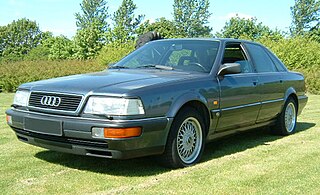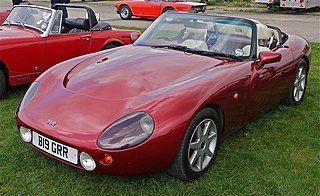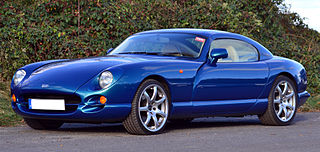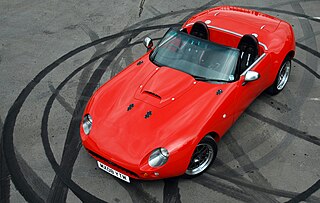Related Research Articles

TVR is a British manufacturer of sports cars. The company manufactures lightweight sports cars with powerful engines and was, at one time, the third-largest specialised sports car manufacturer in the world, offering a diverse range of coupés and convertibles.

The TVR Tuscan Speed Six is a sports car which was manufactured by British company TVR from 1999 to 2006. The name pays homage to the original Tuscan which was introduced in 1967.
The Alta Car and Engineering Company was a British sports and racing car manufacturer, commonly known simply as Alta. Their cars contested five FIA World Championship races between 1950 and 1952, as well as Grand Prix events prior to this. They also supplied engines to a small number of other constructors, most notably the Connaught and HWM teams.
Mercedes-AMG GmbH, commonly known as AMG, is the high-performance subsidiary of Mercedes-Benz AG. AMG independently hires engineers and contracts with manufacturers to customize Mercedes-Benz AMG vehicles. The company has its headquarters in Affalterbach, Baden-Württemberg, Germany.

The TVR S series is a line of sports cars manufactured by the British company TVR between 1986 and 1994. It was announced at the 1986 British International Motor Show. The car went into production in less than 12 months, with 150 pre-manufacture orders placed at the motor show before the moulds were even made.

The TVR Speed Six was the name of a naturally aspirated straight-6 engine manufactured by TVR, and used in several of their cars including the Tuscan, Cerbera, Tamora, T350, Sagaris and Typhon.
The TVR Speed Twelve engine is the name of a V12 engine manufactured by TVR for use in the TVR Speed 12 race car, and later the TVR Cerbera Speed Twelve road car.

The Audi V8 is a four-door, full-size luxury sedan, designed, manufactured and marketed by Audi in Germany from 1988 to 1993, as the company's flagship. As the first car from Audi to use a V8 engine, also was the first Audi to combine a quattro system with an automatic transmission. Early cars used 3.6-litre V8s, while later cars featured a 4.2-litre version of the engine. The Audi V8 was replaced by the Audi A8 in 1994, although the A8 was not marketed in North America until 1996.

The Morgan Aero 8 sports car was built by Morgan Motor Company at its factory in Malvern Link, England from 2000 until 2018.

Alpina Burkard Bovensiepen GmbH & Co. KG is an automobile manufacturing company based in Buchloe, in the Ostallgäu district of Bavaria, Germany that develops and sells high-performance versions of BMW cars. Alpina works closely with BMW and their processes are integrated into BMW's production lines, and is recognized by the German Ministry of Transport as an automobile manufacturer, in contrast to other performance specialists, which are aftermarket tuners. The Alpina B7 is produced at the same assembly line in Dingolfing, Germany, as BMW's own 7 Series. The B7's twin-turbo 4.4-litre V8 is assembled by hand at Alpina's facility in Buchloe, Germany, before being shipped to BMW for installation, and the assembled vehicle is then sent back to Alpina for finishing touches.

The TVR Griffith, later models being referred to as the Griffith 500, is a sports car designed and built by TVR, starting production in 1990, and ending production in 2002. The Griffith name appeared again on a sports car introduced under a revived TVR brand in 2017.

The TVR Cerbera is a car manufactured by the British company TVR between 1996 and 2006. Its name is derived from Cerberus, the three-headed beast of Greek legend that guarded the entrance of Hades. It is a coupé with a hardtop roof and a 2+2 seating layout that has been described as a sports car and a grand touring car.
Alwyn "Al" Melling is a British automobile engineer.
This article gives an outline of Formula One engines, also called Formula One power units since the hybrid era starting in 2014. Since its inception in 1947, Formula One has used a variety of engine regulations. Formulae limiting engine capacity had been used in Grand Prix racing on a regular basis since after World War I. The engine formulae are divided according to era.

The TVR Tuscan Challenge is a one-make series dedicated to the second incarnation of the TVR Tuscan sports car, and takes place throughout the United Kingdom. Inaugurated in 1989, its high power-to-weight ratio, capability of reaching 190 mph (310 km/h) and loud engine noise, combined with close racing in a field consisting of over 30 cars at its peak, made the series become, at the time, the premier one-make series in the UK with an extensive TV coverage; over the years, many drivers who competed in the series moved on in major championship series and many notable drivers have guest driven in a race. The company underwent management changes in 2005, and the TVR Tuscan Challenge was merged with its owner club's series, which has been reformatted to allow for all TVR models.

The Melling Wildcat is a V8 powered sports car produced by Al Melling Sports Cars in Rochdale, Greater Manchester.

The TVR M series is a line of sports cars built by automaker TVR between 1972 and 1979. The series replaced the outgoing TVR Vixen and Tuscan models, and is characterized by a common chassis and shared body style. As with other TVR models before and since, the M-series cars use a front mid-engine, rear-wheel drive layout and body-on-frame construction. The bodies themselves were built from glass-reinforced plastic (GRP). The era of the M series is commonly associated with Martin Lilley who, together with his father, took ownership of the company on 30 November 1965.

The TVR Vixen is a hand-built sports car which was produced by TVR in Blackpool, England from 1967 until 1973. Ford-engined in most of its configurations, it succeeded the MGB-engined TVR Grantura 1800S. It is also the basis for the high-performance TVR Tuscan which was available in both V6 and V8 configurations.

The Jaguar XJ (X350) is a full-size four-door luxury saloon car manufactured and marketed worldwide by Jaguar Cars for model years 2003–2009 as the third generation of the Jaguar XJ saloon, carrying the internal designation X350 and the internal designation X358 following its 2007 intermediate facelift. Both the X350 and X358 were available with a six-speed automatic transmission, a range of petrol and diesel engines, numerous trim levels, and short wheelbase (2003–2009) or long wheelbase (2005–2009) car body configurations. Extended-length models were the longest vehicles Jaguar had manufactured.
References
- ↑ "The Official TVR Website". Archived from the original on 17 June 2000. Retrieved 26 November 2022.
- 1 2 3 Wilcox, Adam (10 August 2022). "Its namesake guarded the underworld, but this TVR Cerbera is a ticket to paradise". Hagerty Media. Archived from the original on 26 November 2022. Retrieved 26 November 2022.
- ↑ King, Graham. "Why The Crazy TVR Cerbera Is A Proper 90s Hero Car". Car Throttle. Archived from the original on 26 November 2022. Retrieved 26 November 2022.
- 1 2 Perkins, Chris (18 December 2018). "The TVR Cerbera Used a Truly Strange V8". Road and Track. US. Archived from the original on 25 November 2022. Retrieved 25 November 2022.
- ↑ "TVR Car Club - TVR Cerbera Details". Archived from the original on 25 November 2022. Retrieved 25 November 2022.
- ↑ Sena, Alvise Marco (1 March 2008). "TVR: The AJP8 engine". Archived from the original on 25 November 2022. Retrieved 25 November 2022.